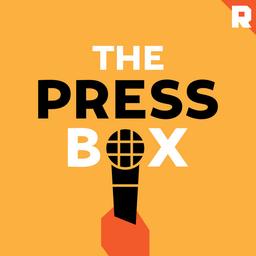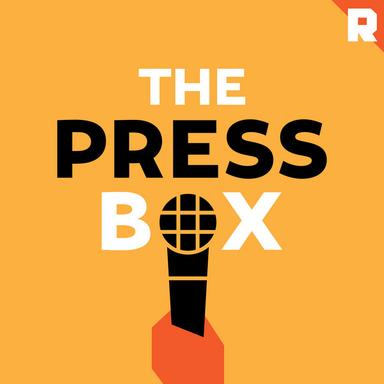This president is, among other things, a pot-stirrer. That’s central to both the image and function of Trumpism. Never apologize, and always agitate. POTUS spent most of this week publicly justifying his decision to send the U.S. military into the nation’s second-largest city as ICE conducted raids throughout California. He did so despite—or maybe in response to—objections from California Governor Gavin Newsom. Protests against Donald Trump’s deportation measures, which had resulted in the detainment of a number of citizens and noncitizens alike, were mostly nonviolent, save for a few intense skirmishes captured on camera. (Though many of these conflicts appear to have been instigated by those ostensibly charged with controlling them.) Those isolated incidents included standard social media–era catnip: empty, flame-engulfed vehicles; masked, non-white protestors; copious foreign flags. At least 160 people have been arrested in L.A. so far, but no reported deaths have occurred.
Newsom, whom the commander-in-chief has sparred with in the past, said Trump was purposefully inflaming the situation. Meanwhile, the president told a group of reporters and propagandist sycophants on the White House lawn that “it would be a great thing” if Tom Homan, Trump’s “border czar,” arrested the governor. Someone from the press gaggle asked Trump what types of people are “causing all the problems in L.A.,” to which he replied, without a hint of irony: “The people that are causing the problem are professional agitators,” adding, “They’re insurrectionists,” before bounding away as his doctored mane billowed in the wind.
It ought to be noted that despite the images that are being transposed in 4K to your TV or social media timelines, Los Angeles is not really burning, but that’s not really the point here. After six months of deportation theater countrywide—scenes including late-night raids, masked abductions, accidental detainments, illegal extraditions, censorious arrests, the trampling of due process, and the institution of daily quotas—the federal eye turned toward Southern California’s sprawling megalopolis and migrant community. At the beginning of June, ICE operations ensued in L.A.’s Fashion District; during one foray, a California union leader was arrested while demonstrating. The large-scale protests began soon after. For Trump, this fomented dissent was particularly advantageous.
His strongest political instinct has always been his sense of when to obscure his failures and what provides the best cover. If tariffs erode an already-skittish economy, best to return with red meat in hand. Who wants to listen to a squabble with an über-rich, jilted political ex when there’s tear gas on television? The crowd at the L.A. protests included, among other subsections, a small group of people who committed property damage and a larger group of people who bellowed tear-stained pleas for the release of their peaceful, detained family members, but the president knows which one of these pictures has the most juice, on- and offline. He also knows the historical parallels: The last time a president sent in the National Guard to a state without the cooperation of its sitting governor was when Lyndon Baines Johnson ordered troops into Alabama to ensure that Martin Luther King Jr.’s march from Selma to Montgomery could occur without disruption.
That it would be mimicked now, as a pretense that’s actually meant to grease Trump’s deportation and censorship efforts, is no mere coincidence. It’s the latest attempt by the administration to take the tactics and language of past presidents, social leaders, and political movements and, rather than wield them to protect individuals on the margins, use them to corral its targets and opposition.
The City of Angels is not lacking for armed reinforcement: The state has at least 75,000 cops total; the county sheriff’s office has a little under 10,000 alone, and the city police department has another 9,000. An influx of interloping military personnel, in the view of the state’s law enforcement brass, complicates, not alleviates, their response to civil disobedience. “Arrival of federal military forces in Los Angeles,” LAPD Chief Jim McDonnell said on Monday, “absent clear coordination, presents a significant logistical and operational challenge for those of us charged with safeguarding this city.”
By that point, Trump had announced he’d be sending in 2,000 National Guard members. Two days later, he increased that estimate to 4,000. That evening, he added 700 Marines to the tally. His defense secretary, Pete Hegseth, told Congress that the military will remain in the area for at least another 60 days. (Newsom sued the administration over its deployment of the National Guard—which, in combination with the Marines, will cost U.S. taxpayers an estimated $134 million—and received a judgment in his favor Thursday evening, though that order was paused by an appeals court hours later.)
Trump—who has, in the past, yearned for the policies of bygone chief executives like the former general Dwight D. Eisenhower—is implicitly tying his actions to not only what he tellingly termed “law and order” but to a batch of civil rights–era executive actions around protests and integration. In 1957, Eisenhower sent the National Guard into Arkansas to ensure that the Little Rock Nine could integrate the city’s Central High School. But unlike Trump today, Ike was both enforcing a Supreme Court ruling and redressing the fact that the governor of Arkansas had previously ordered the Guard not to allow the students themselves onto school grounds.
Five years later, John F. Kennedy similarly ordered the National Guard into Mississippi, but in his case, the entire state government had been willfully obstructing desegregation efforts, violating a court order, and Kennedy had been in dialogue with the governor—something Newsom has said Trump never did (despite what Fox spin doctors have attempted to gild). When President Johnson sent the National Guard into Alabama, he likewise did so to directly protect protestors after a court order allowed them to conduct their Selma march. Trump isn’t enforcing a judicial order or a new law enshrining his current administration’s mass deportation efforts but instead using military personnel to enable immigration officers to uphold a series of legally spurious fiats—most of which involve depriving residents, if not legal citizens, of their due process rights.
That the president might lean on the tactics and language of a previous moment in enacting a largely unprecedented modern policy fits into the pattern of his second term in office. The more controversial the action, the more the administration wraps it in a veneer of familiarity: Anti-DEI ordinances claim to “return to the promise and the hope that was captured by Civil Rights champions” and regard “longstanding Federal civil-rights laws” as “a bedrock supporting equality of opportunity for all Americans,” even as they dismantle them. Executive orders seeking to erode diversity policies in the private sector or mandate a “patriotic” K-12 education bereft of references to race cite, explicitly, “the Civil Rights Act of 1964.” White House officials announce actions that appall the living relatives of MLK Jr. while claiming these measures will ensure that “all Americans can be treated on the basis of their character, not by the color of their skin.” (To say nothing of the fact that Trump announced most of these restrictive measures on the holiday in King’s name, promising to “make his dream a reality.”) At the root of each case has been an attempt to maintain a level of historical traction, though rarely actual faithfulness—if anything, in function, the administration’s behavior more closely mirrors the backlash to the egalitarian movements of the ’60s.
The regime-wide marching orders appear to be about propping Trump up as a strongman in a brutal, chaotic world. Homan, Trump’s border czar, called the folks detained in L.A. “bad people” whom ICE took “off the street.” Stephen Miller, the president’s deputy chief of staff and one of the architects behind the first administration’s family-separation policy at the southern border, called L.A. “occupied territory” and said that “this is a fight to save civilization.” FBI head Kash Patel, who has promoted deep-state conspiracy theories, argued that the city was “under siege by marauding criminals.” Defense Secretary Hegseth branded protestors a “violent mob” who were “facilitated by criminal cartels” and constituted “a huge NATIONAL SECURITY RISK.” In a press release on Saturday, White House press secretary Karoline Leavitt made the case that the California state government had “abdicated their responsibility to protect their citizens.”
What the administration is objecting to, but is too sly to outright admit, isn’t some dystopian crime spree in one of the largest politically liberal voting regions in the country—all you need to do is peep its handling of disaster funding to infer its feelings of responsibility for the material well-being of the citizens of California or any other region that isn’t reliably conservative-leaning. Rather, what figures like Leavitt, Hegseth, Patel, and (especially) Miller are opposing is the lack of acquiescence to their political priorities. When it comes to L.A., that’s the crime. When you hear Trump say, on Truth Social or in front of a helicopter or at the Resolute desk, that it’s “looking really bad in L.A.” or that the city is being “invaded and occupied by Illegal Aliens and Criminals” and torn apart by “violent, insurrectionist mobs” or “lawless riots” and that he’ll have to “BRING IN THE TROOPS,” it has little to do with the actual events on the ground and everything to do with submission to his autocratic orders.
And how those events might be used as a cudgel to beget more power.
Where the endpoint lies in L.A. and any other city that defies his will is anyone’s guess. The protests aren’t going away. Nor, it seems, are the raids. And neither are the soldiers, even if they don’t have much to do. On Saturday, the president will have his military birthday bash in D.C., a marked and continued intermeshing of the commander-in-chief’s cult of personality and the functioning of the armed services. One gets the sense that he’s aware it might get crashed. “For those people that want to protest, they’re going to be met with very big force,” he said in the Oval Office on Tuesday. It sounded, among other things, almost like a dare.


